- Could we begin by asking how you first encountered performing arts?
- At first, I was thinking of becoming a nursery school teacher. In the spring of my last year of high school, when I was studying for the entrance exam of my first-choice university, I happened to go to the performance of a seniors theater company that had come to my home region of Joetsu City in Niigata. I went because I was attracted to the phrase “Educational Theater,” meaning the use of theater as an educational method for nurturing [aesthetic] sensitivity and learning about social issues, and that particular performance I saw was a story about life done in musical form with live music, and I thought it was cool. There was dance and the music was like a live performance with a djembe drum that really impressed me. That experience made me think about what theater really is, and I suddenly decided to change course and find a university that was still open to applications where I could study theater. My mother had been in the drama club when she was in school, so she was supportive of the idea, but my father was always against it. And, I guess that was only natural (laughs).
- You chose to go initially to the Toho Gakuen College of Drama and Music. Why was that?
- My first thought was that drama equals Shakespeare and it appeared that in Japan Shakespeare meant director Yukio Ninagawa , and I heard that Ninagawa-san was the president of Toho at the time, and since I knew absolutely nothing about theater, I chose Toho. After graduating I intended to become an actor and I joined the Saitama Next Theater, which is a resident company for young people at the Sainokuni Saitama Arts Theater directed by Ninagawa-san.
- You acted in the premiere of Sanada Fuunroku (Tale of the Sanada Family) (2009), didn’t you? That production drew attention because they covered the stage floor in mud for the performance.
- Yes. We were battling in the mud (laughs).
- What started your interest in dance?
- It was before I joined Saitama Next Theater, when I saw a performance of one of Pina Bausch’s works. Despite that fact that the performers spoke no lines, they commanded a strong presence that made me feel the embodiment of the human being in them, and it made me feel that everything I had learned in four years at Toho was overturned in a moment. From around that time I began to think that maybe it wasn’t theater I was interested in after all.
- Does that mean that while you were active as an actor at Next Theater your interest in dance was also growing?
- Yes. At the time, Ninagawa-san once said to me, “Didn’t you say at your audition that you also wanted to do dance?” I answered that it was true, but I also had the nerve to say that I wanted to get deeper into the art of acting as well. That was pretty audacious of me, wasn’t it (laughs). But Next was a place for people who were devoting themselves completely to acting. So, after discussing it with the theater, I quit my position in the company after one year.
- How did you gain experience as a dancer?
-
From the start, it wasn’t that I wanted to express myself by “dancing,” but an interest in finding ways that I could express myself with my body instead of with words. About the only experience I had with dance was some lessons in jazz dance, so I started a dance unit named CHAiroiPLIN (first performance “
Sarigenaku pot-au-feu
”, 2007) to participate in Toho’s intra-collegiate cultural event; and that dance company is still together and active today. After that, an audition with Yoko Higashino ’s dance company BABY-Q brought me regular work as a dancer ( Matar o no matar in 2008, Rhizome na M in 2009, etc.), and I also participated as a dancer in productions of Un Yamada ( Kaeru in 2009, Shomen in 2010) and Mikuni Yanaihara (the Nibroll performance of THIS IS WEATHER NEWS in the 2010 Aichi Triennale).Thanks to the opportunity I took to participate in a workshop and performance event by the Pina Bausch Dancetheater Wuppertal company member Jean Sasportes organized by Kagurazaka Session House (*), I got the chance to dance with the Mademoiselle Cinema company became able to perform our CHAiroiPLIN original works regularly at the Kagurazaka Session House.
- From 2010 you became a member of the Condors company led by Ryohei Kondo .
- That resulted from my participating in the Condors’ Kyoto retreat workshop and having Kondo-san invite me to perform his choreography in a Session House production (2010, “ Rittai Ehon” – Uruwashiki mountain goat ). Just by chance, that was the first time I had ever danced to choreography by a man, and perhaps that is why I eventually settled into being a member of Condors. After becoming a member, I stopped auditioning and performing with other companies.
- While dancing in a number of choreographers’ works and continuing you activities with CHAiroiPLIN, you also started the theater unit tamagoPLIN in 2010.
- I guess it is because I wanted to create [stage] works myself. Both Higashino-san and Un [Yamada]-san are types who don’t just hand you a piece of choreography to perform, instead they say, “I’m giving you a working theme and I want you to think about what to do with it,” so they are types that get the dancers to make suggestions. Theirs’ is the kind of working method that has influenced the way I work today, I believe.
Initially, tamagoPLIN was formed when underclassmen of mine from Toho University who called themselves Performance Shudan Tamago came to me seeking advice because they wanted to create a work to compete with in the Sengawa [Theater] Drama Contest. So, I combined their group with my CHAiroiPLIN unit as a limited-term group. The work we created then was Kuso Ishi (Fantasy Stone, 2010), based on the manga by Shigeru Mizuki, and it won the Audience Prize in the 1st Sengawa Drama Contest. For our Winners Performance the following year, we created Saiai – Shakespeare Recipe (Love of Vegetables – Shakespeare Recipe).- That work ( Saiai – Shakespeare Recipe ) later won many awards, including the Tiny Alice-organized “Dramaturgy x 2011” (Grand Prix and Audience Award), the Young Director Contest 2011 (Excellence Award), the 9th Suginami Theater Festival (Excellence Award) and the 3rd Setagaya Ward Arts Award “ Hisho ,” and it has been re-staged numerous times since. It is a fantasy story about the members of the drama club of a girls’ high school who are having trouble with interpersonal relations. They meet a group of vegetables and together they learn about human nature by reading Shakespeare’s works. Where did the idea of connecting vegetables with Shakespeare come from?
- Before I wrote this work, I was asked to write a work for children for the RAFT theater in Nakano, Tokyo, and I decided to make it a story about vegetables (2010 Children and Theater Okawari Yasai (Another [serving of] Vegetables). At the time, I was discouraged with interpersonal relations and I was searching for a subject that didn’t involve human beings, and what came to mind was vegetables. When I started thinking at length about vegetables, I found dramas in them. For example, there is the onion that, no matter how many layers of outer skin you peel away, you never reach any core, and it cries, “I am an empty being.” And there is the green pepper that all [children] hate, and the carrot (the first character of which is the same [Chinese] character for “person” as the first character of “human being”) that is troubled by an unrequited desire to become a human being that will never be realized.
- So, Saiai – Shakespeare Recipe was an outgrowth of your discovery of the potential for personification of vegetables?
- That’s right. As I was forming my ideas for that play, I was reading a book by Yushi Odajima that had the words, “If human beings have a heart it is for the purpose of loving [others]. That is what Shakespeare wrote about.” Those words inspired me to make a story about vegetables learning about love. It is a story about disliked vegetables, unloved vegetables studying the texts of Shakespeare to learn how to become loved by human beings.
- How did you put the elements together into a story?
- I looked for places in Shakespeare’s works where the word “love” appear and then I made scenes in étude (study) form with those different passages as the core for each one. In Shakespeare’s plays the word love is used often in the sense of romantic love, but there are actually few places where it is used in the larger, more abstract sense of universal love or love for humankind. When I marked those latter uses, I found that there would sometimes only be about four places it was used that way in each play. The spoken lines in Shakespeare’s plays are long, but I found the important things are said at the beginning and ends of the lines while the middle portions are written in a way that is intended to expand on images in the listener’s (reader’s) imagination. So, in writing my script, I wrote only used the parts [at beginning and end] that clearly stated the meaning intended, while for the [middle] parts [expanding on images], I translated them into physical movement as dance parts. Also, I thought about ways to communicate the meaning clearly to the audience. For example, with Othello , since the handkerchief is used an important item symbolizing infidelity, when the word handkerchief appears, I have a handkerchief dropped (laughs). I used that kind of thinking to create the [dance] movement. In short, I want to make it into something playful.
- Indeed, “playful” may be a key word when talking about your works. In your CHAiroiPLIN “Dance Play” series where we take plays as our subjects, for your production of The Nutcracker (script by Shuji Terayama, directed by Takuro Suzuki) performed at Seigakan theater in March (2016), the story itself has dark portions but you never let it get heavy, instead you kept the story progressing in an enjoyably playful way.
- I guess I like to give the dark scenes a playful aspect that lets the audience think about its contents in a subjective manner.
- Another characteristic of your directing is that you seem to have a preference for group-action staging. In another of the plays in your “Dance Play” series, Match-uri no Shojo (The Little Match Girl), you staged it with a number of girls instead of one.
- I wonder why (laughs). It may be that, because a problem or anxiety becomes heavier when you try to carry its weight alone, I want to lighten the load by spreading the weight around [to a group]. Basically, my approach is that being with a group is better than being alone, and having others around increases the possibilities [of things getting better, etc.]. And, it also may be that, for me, a group represents a “family.” The importance of the family as the smallest social unit has always been something I have wanted to express through theater and dance.
- You say that you create scenes in étude (study) form, but before you begin the working sessions in the studio do you tell the actors/dancers your interpretation of the play as the director and do you present your directorial plan?
- I don’t talk about things like that in the studio. Although I do talk about them sometimes when we are out drinking (laughs). To the actors/dancers I say, “The answers are here (in the play), but I have no intention of staging it as it is. I want you to read the [original] play, but there is no need to memorize it. Let’s think about it in the studio.” Of course, in my own mind I have an interpretation of the play, but I don’t want to use that as the starting point for our work in the studio. If I tell them my interpretation, that will narrow the creative possibilities. In a case like The Little Match Girl , I will simply say, “Let’s make a dance of striking matches,” but I don’t say what I want the dance to be like or why I want to make the dance. That expands the possibilities, and of the various ideas and movements that come out I will say, “OK, which of these fit with such-and-such an interpretation?” And that is how the choices are made. But, unlike what you might expect, I usually find that everything fits in the final dance or scene we make.
- It seems to me that dance and music are more direct forms of expression than words, because the reach the audience directly without having to go through the filter of meaning.
- I really believe that is true. You might say that the base of words is lies, or that the more you talk about something, the more difficult it can become to communicate something. Arriving at mutual understanding through works is really not as easy as it might seem. In my case, I think it is because the left hemisphere of my brain doesn’t work (laughs). I just don’t know how to construct an interpretation [of a play logically] in the usual sense of a theatric interpretation.
- What was your intention in starting your “Dance Play” series?
- Since my initial training is as an actor, there are many plays that I like. I thought I wanted to do those plays, but there are already a variety of companies doing them in the usual way, so I thought that it would be meaningless if I did the same thing. So, although it is a simple idea, I thought it would surely be interesting to dance to a play script. I saw several stage productions of Kobo Abe’s play Tomodachi (Friends), but I never found the second half of the play attractive in them. So, I felt that there was the possibility of making it better by adding physical elements or dance that was interesting to me. Our “Dance Play” series was officially concluded with our production of The Threepenny Opera , but I still have an interest in doing dance that has a narrative, “story-telling” aspect. I want to continue to create works that use things like plays, storybooks and rakugo comedy for the narrative element.
- Do you have little interest now in doing completely original works?
- I have written original scripts like Saiai – Shakespeare Recipe and Azuki – Otsu-na-aji-ichinotsugi (2012), but basically I think it is better to do plays by great authors. Even if I tried doing autobiographic-type works about what my thoughts are now, there hasn’t been very much human drama in my life so far (laughs). Because I started out as an actor, you might say I can’t go out on stage unless I am acting as something, or you could say that I have no thought of performing as myself. For example, with Condors we go out and perform wearing school uniforms, right? So, it is like returning to my school days. Because of that, I can always perform with the feeling of a somewhat younger body, and I can go out on stage with a young spirit.
- It is hard to keep a playful spirit when you are facing yourself seriously, isn’t it?
- Exactly. You could say I need a toy, or you could see it as a process of using something outside of oneself to see and know oneself better. That is the only way I can choreograph. In a sense, I personally believe it is close to the thinking behind Butoh dance. In Butoh, you don’t move based on your own volition, but rather, like the drifting smoke of tobacco, they say that your movements should be based on the movement of the air around you, don’t they?
- When you choreograph for others, do you need to assign a role for them?
- Well, yes. You could call it something like a leash; I believe that acting out a role is a process of placing certain restrictions on your actions. For example, if I say, “Now we are going to choreograph movement based on the theme of blowing up a balloon,” you have “the person blowing up the balloon” and “the balloon” itself, so a situation is set where it is not about yourself. When I am choreographing, I have never thought about, “How do I show myself?” I need to have something like a role to define it.
- Have you learned a lot from the way Condors create a stage piece?
- I guess I certainly have learned a lot. Each of the members of Condors has their own role in the creative process. While Ryohei [Kondo]-san is thinking about the choreography, the other members are doing things like preparing the [video/slide] visuals or making the necessary props; everyone thinks for themselves what their job will be and acts accordingly. There are also people who will decide that this is the time I should take a rest (laughs). And, for example, when Ryohei-san is talking with the producer Yasuharu Katsuyama, the rest of us know that it is best not to say anything, and things like that. These are the reasons that the group has continued to be active for twenty years now, I believe. Ryohei-san is the kind of artist who can naturally and brilliantly show that he wants to create expression as a group, not self-expression but learning about yourself from through the relationship of working with others. In this way, he has been a very valuable example for me.
- In the sense of wanting to create things together with other, it seems to me that you also have what might be called the Condors spirit, don’t you?
- I do. If it is not in that way [of working together with others], I can’t create works. In our group, we make all of our own props, and we say things like, “Let’s build the set ourselves,” and, “Let’s take it down by ourselves afterwards,” and, “Let’s make the costumes too, and everyone do your own laundry.” (Laughs)
- You also use live music often in your stages. Is music important in your creative process?
- Yes, it is important. The music creates a rhythm for you, and it can also create changes in mood and emotions. When I think about why I like choreographing, I believe it is because I like letting my imagination flow while listening music. I think you can communicate things more quickly through music than through normal talking; and what can I say, it’s not as bothersome (laughs). So, in my case, when I need to create a work, the first thing I do is to listen to lots of music. In the Ochanomizu district (of Tokyo) there is a used record shop that I go to often. And since they have a lot of strange records, I set a period of about four days that are my “listening to music days,” and I just spend all that time listening to music. During that time, I will suddenly get ideas. First, I fill my brain with music, and when the right hemisphere of my brain is swelling with music, input something like a puzzle that forces me to use the left hemisphere of my brain. When I do that, it changes everything to play. What I have just said is rather abstract, but that is the working order is like when I am creating something.
Music is something that you can enjoy unconditionally, with no particular efforts or strings attached, isn’t it? I want to create stages that can be enjoyed that way. With dance that is music-like, and theater that is like music. It should be a form of unconditional entertainment, I believe. Even if the content is a very complex and serious drama (play), it can be softened if you first create an enjoyable world by coloring the overall framework with music. It can be like a cup of instant ramen noodles, where just adding hot water quickly makes the hard noodles soft (laughs). But even when the noodles soften, the taste remains the same.- While you were a student at Toho university, the Sengawa Theater (seating: 121) opened nearby in Chofu city in 2008 and became closely tied to the university, and you were involved in a variety of projects there.
- The artistic director of Sengawa Theater when it first opened was Peter Gössner, who was also an instructor at Toho. Through that connection, I took part as an actor for the first time in the play Ai-tte nani? (What is love?, production by Sengawa Theater Ensemble) directed by Peter-san.
- The Sengawa Theater is next to a nursery school and they have a strong focus on projects for children, and there are also community participation programs, making it a theater with very close ties to the local community. You often do the choreography for the theater productions put on by the Sengawa Theater. It must give you an opportunity meet and work artists and encounter audiences that you wouldn’t otherwise meet doing your own productions, doesn’t it?
- The Sengawa Theater does projects and performances for a wide audience demographic, from children to grandpas and grandmas, and the program genres range from classical music and jazz to theater, dance and more. When I look at the audiences at the performances there, the responses are varied and interesting, and it gives me a variety of answers regarding the work I have done for their productions.
- I imagine that this contributes to the great breadth of [subjects and age groups] your works cover.
- Well, yes. It gives me opportunities to work with a variety of directors, and bring variety in terms of the things they want from me. I wouldn’t say that these experiences influence the way I create works, but it has increased the number of things in my toolbox. I feel that it is the experience I have gained working at Sengawa Theater that has made me comfortable now when people ask me to choreograph for productions outside of my own productions.
- These days, it appears that you are working on some project or other at a pace of about once a month.
- I believe it is important for me to constantly keep my engine running strong. Since I can’t be doing work with my own company all the time, I feel it is important during the other times to keep meeting a variety of new people and to always keep my antenna out for new inspirations. Also, I believe that it is good for artists to be doing a variety of work regardless of the genre. Rather than only doing theater or dance, I think it is good to also do other things, like playing with children, taking trips, painting pictures and the like. It is in the process of doing a variety of things that you find the things that you want to do.
Lately, I have been working frequently with Kenichi Aoyama-san (video, promotional art creator) and says something interesting: “When I do a self-portrait it is finished rather quickly. But, when I paint things around me, it goes on and on indefinitely.” I also feel that I like the way of painting where you express myself by portraying the things around you. Working with a variety of directors, I find that learning what interests the other person inspires me to identify and show what interests me and to paint together with that person [to create something]. I believe that if I don’t have that kind of contact with other people, I don’t find things that I want to do.- You were selected for the Agency for Cultural Affairs “East Asia Cultural Exchange Ambassador” program and did workshops in Seoul, South Korea with that program. Also your production of Tomodachi (Friends) toured South Korea in 2015.
- Yes. It seems that my works are very compatible with the tastes of people in South Korea, and they enjoyed them. In the East Asia Cultural Exchange Ambassador program I did a three-day workshop taking The Threepenny Opera as the subject, and the resulting performance turned out to be of quite high quality. It was a 30-minute performance with six scenes, and it is quite difficult to do something like that in such a short time. But the participating [Korean] actors were very capable, and they could dance and memorize things in one day. I also had them make the costumes, which they also did in just one day. They appeared to have no hesitancy concerning my working method, and even the language barrier didn’t feel like an obstacle. That experience made me feel that my working method of turning things into amusing play is an effective one regardless of differences in nationality.
- You truly appear to be busy with a broad range of activities.
- I am grateful for that fact. Working at a number of places on an ongoing basis is a style I like, and I have decided that once I get involved in something I want to keep doing it on a continuing basis. Doing choreography for the Tsubaki-gumi company is one of the things I have been doing on a continuing basis, as is my work with Condors and Sengawa Theater, and I want to continue them all. Because, quitting is too easy. I want to think about ways to keep these things going.
*Kagurazaka Session House
An art and dance studio run by a private-sector organization. On weekdays there are open classes in ballet and contemporary dance, and it is known as a small theater having contemporary dance performances on weekends. The Session House Planning Office also focuses on programs for nurturing young dancers by organizing a variety of dance programs such as “Theater 21 Festival” series, “D-ZONE” and programs by Ryohei Kondo. The resident dance company is the Mademoiselle Cinema company led by Naoko Ito (dance department supervisor). There are also resident artist programs.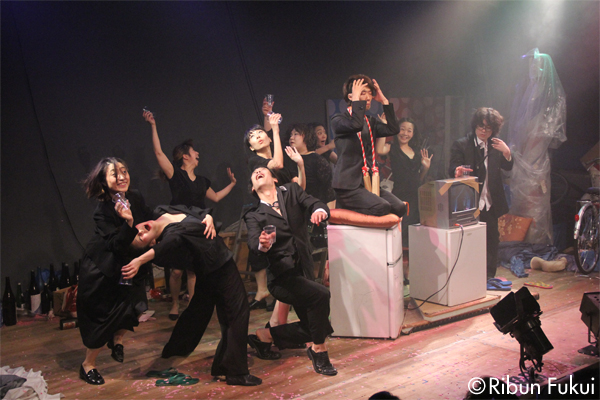
CHAiroiPLIN vol.7
Sakuranbo
(Cherry)
(Mar. 12 – 15, 2015 at Geki Sho-Gekijo)
Photo: Ribun Fukui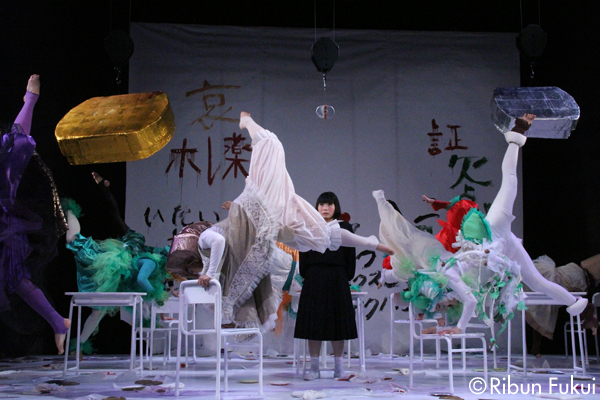
tamagoPLIN
Saiai – Shakespeare Recipe
(Feb. 21 – 23 ,2014 at Theatre Trum)
Photo: Ribun Fukui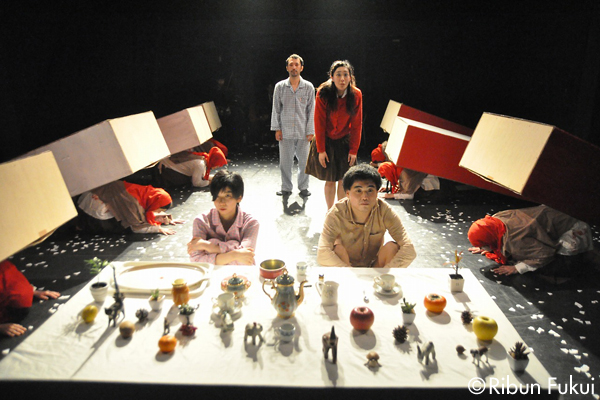
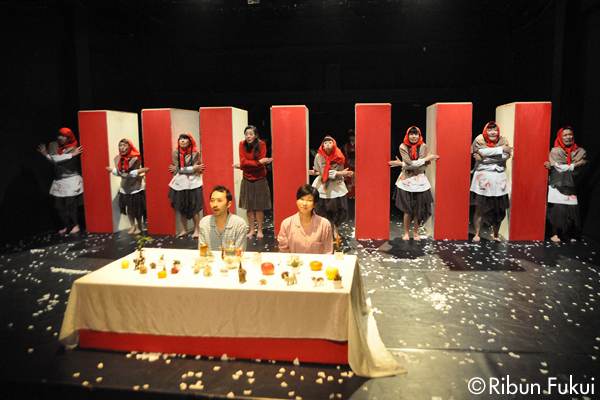
CHAiroiPLIN vol.6 “Odoru Gikyoku 2”
Match-uri no shojo
(第3回世田谷区芸術アワード“飛翔”受賞者公演)
(Nov. 6 – 9, 2014 at d-soko)
Photos: Ribun Fukui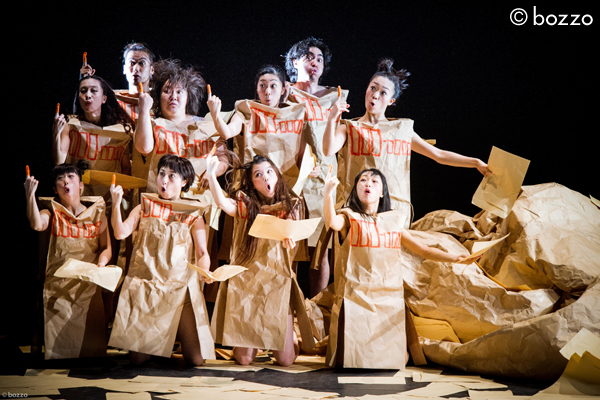
Toyota Choreography Award “Nextage”
〒〒〒〒〒〒〒〒〒〒
(Aug. 3, 2014 at Setagaya Public Theatre)
撮影:bozzo
Takuro Suzuki
Driven by “playful spirit,” the dance theater of Takuro Suzuki”
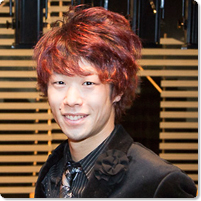
Photo: Yoshiaki Amada
Takuro Suzuki
Since establishing his dance company CHAiroiPLIN in 2007, Takuro Suzuki (b. 1985) has been active widely as a choreographer, director and dancer. He won attention with his work Saiai – Shakespeare Recipe (2011) performed by the unit tamagoPLIN in 2011. Winner of numerous awards, this fantasy play tells a story in which high school girls who are having trouble in their human relationships are joined by vegetable characters as they learn about love by reading lines from Shakespeare plays.
As a dancer, Suzuki joined in 2011 the Condors unit that dances in school uniforms and has continued to perform with them in Japan and abroad. In recent years, he started a “dance theater series” in his works for CHAiroiPLIN, which thus far have included the works Friend (based on the play by Kobo Abe) and Match-uri no shojo (The Little Match Girl, based on the play of the same name by Minoru Betsuyaku). Suzuki uses live music, ideal visuals and a fusion of dance and theatrical performance to create festive works that have won popularity among children and adults alike. Also, Suzuki was selected as a 2015 “East Asia Cultural Exchange Ambassador” by Japan’s Agency for Cultural Affairs and, as such, held workshops in Seoul, South Korea among other overseas activities.
CHAiroiPLIN
https://www.chairoiplin.net
Interviewer: Fumiko Kawazoe

